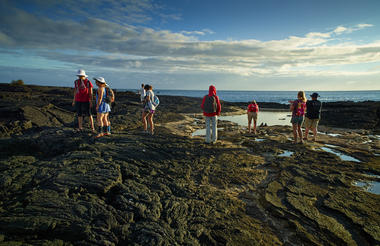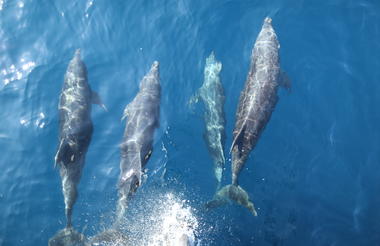Ecuador, a jewel of 109,483 square miles in northwestern South America, sits proudly on the Equator between Colombia and Peru. This enchanting land is home to the majestic Northern Andes, the verdant edges of the Amazon Basin, and a Pacific coastline caressed by both warm and cold ocean currents. Farther out, 600 miles offshore, the legendary Galapagos Islands await—a world of wonder and discovery.
From the towering peaks of the Andes to the vibrant biodiversity of the Galapagos, Ecuador promises an experience unlike any other. Here, ancient cultures thrive alongside stunning natural beauty, inviting you to explore, connect, and marvel. Whether hiking among volcanic landscapes, wandering through historic colonial cities, or encountering wildlife found nowhere else on Earth, Ecuador will leave you inspired and transformed.
San Cristobal Island is made up of two coalesced volcanoes. The southwestern half is asymmetric shield volcano made up of gently-dipping lavas and capped by a thick, deeply-weathered pyroclastic blanket and numerous satellite cinder cones. The southwestern shield became emergent around 2.4 million years ago; activity continued up to about 650,000 years ago. The northeastern half of the island is a more recently active volcano, dominated by eruptions from NE-trending fissures. The most recent flows are no more than a few centuries old.
San Cristobal Island is the only island with permanent freshwater, located near the highest part of the island (south) in a small lake called El Junco. The southern portion of the island is characterized by its rich vegetation, a result of the more humid climate.
Charles Darwin reported encountering a pair of giant tortoises feeding on cactus during his first landing on San Cristobal Island in 1835. Today the airport of this easternmost island in the chain is increasingly used as the arrival point for flights into and out of the Galapagos. The administrative capital for the province is Puerto Baquerizo Moreno on the southwestern shore, and in 1998 the Galapagos National Park Interpretation Centre opened for the benefit of islanders and travelers alike, presenting a comprehensive exhibit of the islands' natural history, human interaction, ecosystems, flora, and fauna. It is also the place where cultural activities take place, including theatre, exhibitions and workshops. From the Interpretation Center, a 3-kilometer loop trail arrives at Frigate Bird Hill, where both magnificent-frigates” and great-frigates can be seen in the same colony—ideal for learning to distinguish the two bird species. A 45-minute bus ride from town takes you to “El Junco,” one of the few permanent freshwater lagoons in the islands. Its location in the highlands of San Cristóbal ( 2,300 feet or 700 meters ) ensures our passage through a variety of vegetation zones. The lagoon on San Cristobal Island offers a scenic setting for exceptional bird watching including frigate birds that, in spite of being sea birds, go there to rinse the accumulated salt from their feathers.
Heading up the coast from Wreck Bay and Puerto Baquerizo, you will see Isla Lobos across a small channel off the coast of San Cristobal Island. This basalt island outcropping lives up to its name of “Sea Lion Island,” with its noisy population of frolicking and barking beasts. It is also a nesting place for blue-footed boobies and an excellent spot for snorkeling while on Galapagos cruises.
Playa Ochoa is located 6 miles from Puerto Baquerizo Moreno, the capital of San Cristobal Island and the Galapagos. The beach is small with easy access; here you'll find the Chatham mockingbird and various species of Darwin finches. Toward the rear of the beach is a little hyper-saline pond where white cheek pintails can often be seen wading. The beach also provides a chance for some introductory snorkeling.
Leon Dormido, also know as Kicker Rock, is a spectacular formation that rises 152 meters ( 500 feet ) out of the Pacific 4 miles off the central western coast of San Cristóbal. It takes the form of a sleeping lion or the Sphinx if you look at the rock from the south, but from the north, you can see that the stone is split, forming a large tablet and, piercing the sea, an excellent chisel ready for etching. Small vessels can navigate through the narrow channel between the two rocks that form Kicker Rock.
La Galapaguera is a tortoise reserve in seminatural conditions. This beautiful facility was built by the Galapagos National Park Service to provide the chance for visitors to San Cristobal Island to take a look at another race of giant tortoise, the Saddle Back. To reach the reserve, it's necessary to take a bus across the island from west to east. The ride takes 1 hour and the facility offers a dirt trail of easy access where 25 adult tortoises can be found in company with the very first babies to be born in captivity in this facility.



The scenic Ecuadorian islet of Isla Lobos is set off the northwestern coast of San Christobel Island, just a few kilometres from the fishing town of Puerto Baquerizo Moreno. This tiny flat island serves as a beautiful sanctuary and is an excellent destination to spot an array of protected species and wildlife including the blue-footed boobies, frigate birds, marine iguanas, fur seals, tortoises and sea lions. Tourists can look forward to close encounters with several aquatic species such as manta rays, red crabs, schools of fish, and hammerhead sharks while snorkelling. Don't miss the opportunity to explore the white-sand beaches lapped by crystal-clear turquoise waters, snorkel through the underwater wonderland off the shores of the beautiful Playa Ochoa, and discover the botanical and ecological wonders of Lobos.



As previously described



As previously described



As previously described


As previously described
Floreana is composed of a series of eroded volcanic hills whose form makes it virtually impossible to identify a central volcano. There are no signs of recent volcanic activity.
As reflected in its many names, Floreana Island has had a colorful history: Pirates, whalers, convicts, and a small band of somewhat peculiar colonists—a self-proclaimed Baroness among them—who chose a Robinson Crusoe’s existence that ended in mystery and death. Today roughly a hundred Ecuadorians inhabit the island. In 1793 British whalers set up a barrel as Floreana Island's Post Office to send letters home on passing ships. The tradition continues to this day, only by dropping a postcard into the barrel without a stamp. The catch is you must take a letter from the barrel and see that it gets to the right place. That is how the system began and continues to this day.
Punta Cormorant in Floreana Island offers two highly contrasting beaches; the strand where we land is composed of volcanic olivine crystals giving it a greenish tint that glitters in the sun. We descend here on our Galapagos cruises, and a trail crosses the neck of an isthmus—that rises from behind a small cinder cone—to a beach of very fine white sand known as “Flour Beach.” The erosion of coral skeletons formed Flour Beach. Between the two shores of Floreana Island is a hyper-saline lagoon frequented by flamingoes, pintails, stilts and other wading birds. Some 700 ft. north from the point is an old submerged volcanic cone that has been worn down by waves; Devil's Crown is home to a myriad of marine species including several species of corals, sea urchins, and many other creatures including a significant number of fish species, making this place one of the best snorkeling sites in the Galapagos. The eroded crater walls of Devil's Crown form a popular roosting site for sea birds including boobies and pelicans.



As previously described



As previously described
Different parts of the island have varied origins, some with fresh lavas and spatter cones and others consisting of eroded tuff formations. Baltra Island used to be a US Air Force Base during World War II.
American soldiers in Baltra Island patrolled the nearby waters of the Pacific Ocean, including the entrance to the Panama Canal, for enemy aircraft carriers, warships, and submarines. When the war ended, the facilities in Baltra Island were handed over to the Ecuadorian Government.
Up until 1986, Baltra Island was home to the only airport in the Galapagos Islands. The airport now shares flights to the Galapagos with the San Cristobal Island airport, but it still receives the majority of flights from the mainland. Most cruise operators also start their cruise operations from Baltra Island. Also, because of its proximity to the largest port town in the Galapagos Islands (Puerto Ayora), most tourists who do island-based tours choose to arrive at the airport on Baltra Island.




